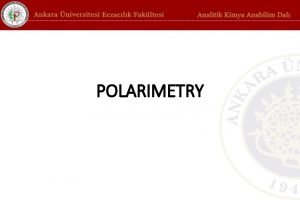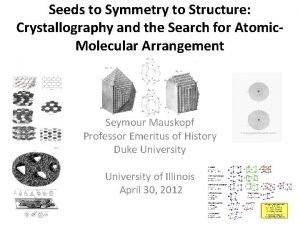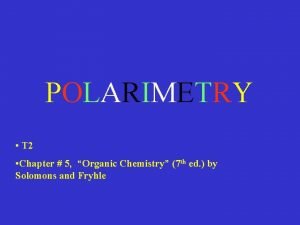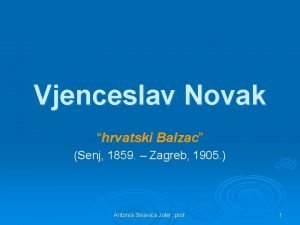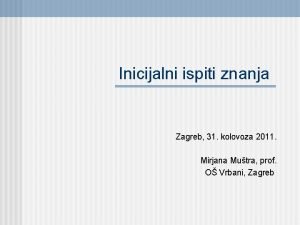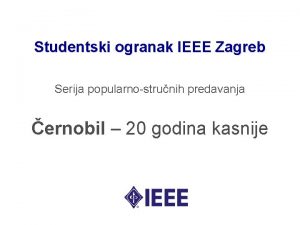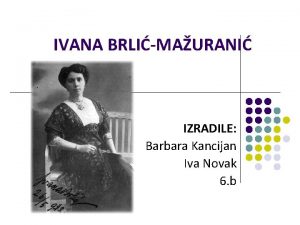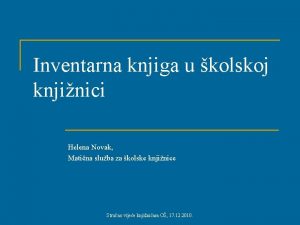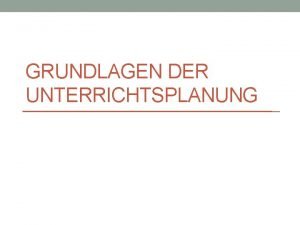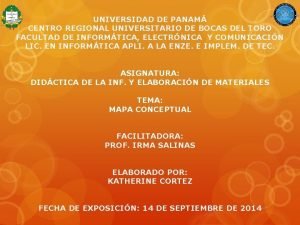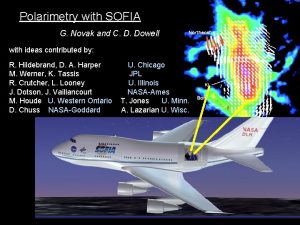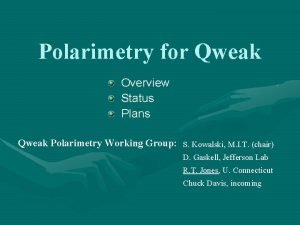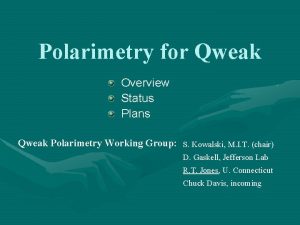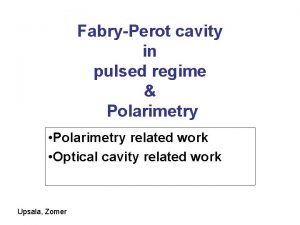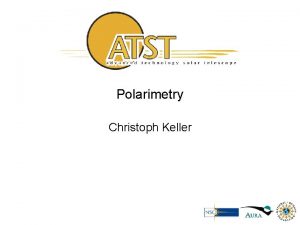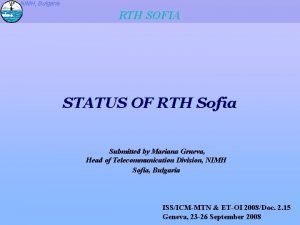Polarimetry with SOFIA G Novak and C D




















- Slides: 20

Polarimetry with SOFIA G. Novak and C. D. Dowell with ideas contributed by: R. Hildebrand, D. A. Harper M. Werner, K. Tassis R. Crutcher, L. Looney J. Dotson, J. Vaillancourt M. Houde U. Western Ontario D. Chuss NASA-Goddard U. Chicago JPL U. Illinois NASA-Ames T. Jones U. Minn. A. Lazarian U. Wisc.

Outline -- using far-IR/submm polarimetry to study star formation -- 3 examples from recent past -- capabilities of SOFIA

B-fields may strongly influence star formation -- mechanical support by strong B-fields may explain the low overall efficiency of the star forming process (e. g. , Shu et al. ‘ 87; Mouschovias & Ciolek ‘ 99; Basu & Ciolek ’ 04) -- B-fields may solve the “angular momentum problem” (e. g. , Allen et al. ’ 03, Shu et al. ‘ 04) -- “…supersonic turbulent flows rather than static magnetic fields control star formation. ” … Mac Low & Klessen 2004 (see also, e. g. , Hartmann et al. `01; Elmegreen & Scalo `04) -- Zeeman molecular line observations provide for direct measurement of magnetic field strength (e. g. , Crutcher ‘ 99; Bourke et al. ’ 01; Crutcher et al. ‘ 09)

simulated GMC 3 -dimensional simulation of magnetohydrodynamic (MHD) turbulence; - compressible - high Mach # - incl. self-gravity - isothermal strong B-field sf = 9. 6° INFERRED B Ostriker, Stone, & Gammie (2001)

simulated GMC weak B-field sf = 45. 3° can determine |B| from sf (Chandrasekhar & Fermi 1951) INFERRED B Ostriker, Stone, & Gammie (2001)

cartoon from Crutcher ‘ 06 shows the idea behind “laminar” models of … -Galli & Shu ’ 93 -Fieldler & Mouschovias ’ 93 -Allen et al ’ 03 -Shu et al ’ 04 … etc.

first observation of a magnetic hourglass in a lowmass star forming region (NGC 1333 IRAS 4 A) straight part of the hourglass seen by SHARP (Attard et al. ‘ 09) “waist” of the hourglass seen by SMA (Girart et al. ‘ 06) SHARP SMA “…at [the Class 0 phase] magnetic fields dominate over turbulence as the key parameter to control the star formation process. ”

Example #1: The laminar models assume oblate cores, with B-field parallel to axis of symmetry. . . submm polarimetry can check this… (Tassis et al. ’ 09; data from Hertz) B-field

Angle (l) between observed B-field and observed short axis vs. observed aspect ratio (q) The data are reasonably well fit by oblate cores with B-field parallel to axis of symmetry … but the very best fit has a 24° misalignment between B-field and sym. axis more elongated rounder

Example #2: dispersion of large-scale GMC B-fields: comparing observations with turbulence simulations Ostriker et al. ‘ 01 provided three models, of varying field strength; in the following papers we show that the weak field model is inconsistent with the observations: Li et al. ’ 06 – SPARO Novak et al. ’ 09 – SPARO + Hertz Li et al. ’ 09 – Hertz + SCUBA-POL + optical polarimetry Mc. Kee & Ostriker paper on “Theory of Star Formation” (Ann. Rev. Astron. Astrophys. ) : “GMC magnetic fields are not too weak, however: 450 micron polarimetry of four GMCs shows that the orientation of the field appears to be preserved during the formation of the GMCs and that the energy in the field is comparable to the turbulent energy (Li et al. 2006). ”

Example #3: use of polarization angle structure functions to study magnetized turbulence Hildebrand et al. ’ 09; Houde et al. ’ 09 - turbulent correlation length: 16 mpc - magnetic field strength: 0. 8 m. G - new analysis including SMA data finds high-frequency cutoff in the power spectrum at 6 mpc (Houde et al. , in prep. ) OMC-1 (SHARP)

SOFIA is a significant step forward in sensitivity to extended dust emission.

JPL Polarimeter for SOFIA/HAWC half-wave plate encoder SOFIA (NASA photo) HAWC • Project goals: – Complete polarimeter hardware via JPL R&D funds. – Apply to NASA SOFIA program in 2011 for integration, commissioning, data analysis. cryogenic DC motor (L. Looney, U. Illinois) to spin half-wave plate cryogenic stepper motor to select wavelength half-wave plate mechanical design for four-band far-IR polarimeter

Example SOFIA Coverage: Orion KAO polarization map: Schleuning (1998) contour: pointings where s(P) < 0. 3% in 4 minutes with SOFIA

Present and Future Detectors HAWC has a modest, but sensitive, array of 384 detectors: Spitzer/MIPS used a 1000 -element array at 70 mm. SCUBA 2, which started shared-risk science last week, plans to field 10, 000 detectors total at 450 and 850 mm. Herschel/PACS is using a 2000 -element detector array in its 60 -130 mm camera. NIST, JPL/Caltech, and Goddard are working on FIR-mm arrays with 100010, 000 detectors.

Why SOFIA? -- signal-to-noise: observe at peak of GMC spectrum; e. g. , SOFIA Design Reference Mission Case Study by Novak et al. 2005 estimates 100, 000 vectors in nine fields during 113 hours of observation -- angular resolution: 5 arcsec at 53 mm; 3 mpc at r Oph -- polarization spectrum: Grain alignment prescription is a key input for any cloud/core polarization model. Many experiments provide access to “submm rise”, but SOFIA will provide the only access to “far-IR drop”

polarization spectrum of GMC envelopes (Vaillancourt et al. ’ 08) far-IR drop: alignment enhanced by IR radiation from embedded sources? submm rise: Draine & Fraisse ‘ 08 Bethell et al. ‘ 07

polarization spectrum of GMC envelopes (Vaillancourt et al. ’ 08) HAWCpol BLASTpol Pol 2 far-IR drop: alignment enhanced by IR radiation from embedded sources? submm rise: Draine & Fraisse ‘ 08 Bethell et al. ‘ 07

a further advantage of far-IR polarimetry: Tamura et al. (1999) there can be more than one polarization mechanism Dowell (1997) Novak et al. (1997) Sagittarius B 2 Kwon et al. (2009) (figure from Stahler & Palla 2004)

Summary polarimetry of dust emission is allowing direct comparisons with theoretical models – both laminar and turbulent. key question: what role do interstellar magnetic fields play in star formation? SOFIA will uniquely access the “far-IR drop” polarimetry of disks and infall envelopes with SOFIA may provide a new window on grain properties in these sources; probing grain coagulation and planet formation first-light SOFIA far-IR polarimetry can be attained reasonably quickly and inexpensively via HAWC-POL
 Dr sofia novak
Dr sofia novak Polarimetry definition in chemistry
Polarimetry definition in chemistry Biots law polarimetry
Biots law polarimetry Polarimetry organic chemistry
Polarimetry organic chemistry Novak djokovic born
Novak djokovic born Nezasitnost i bijeda tema
Nezasitnost i bijeda tema Slidetodoc. com
Slidetodoc. com Hrvatski balzac
Hrvatski balzac 黃鍔
黃鍔 Hiyerarşi kavram haritası
Hiyerarşi kavram haritası Oš vjenceslav novak
Oš vjenceslav novak Antonija novak
Antonija novak Vjenceslav novak černobil
Vjenceslav novak černobil Aldo novak
Aldo novak Vjenceslav novak ebrd
Vjenceslav novak ebrd Iva novak
Iva novak Inventarna knjiga
Inventarna knjiga Planung von unterricht
Planung von unterricht Anica novak
Anica novak Divlji konj analiza likova
Divlji konj analiza likova Novak y godwin, 1999
Novak y godwin, 1999

